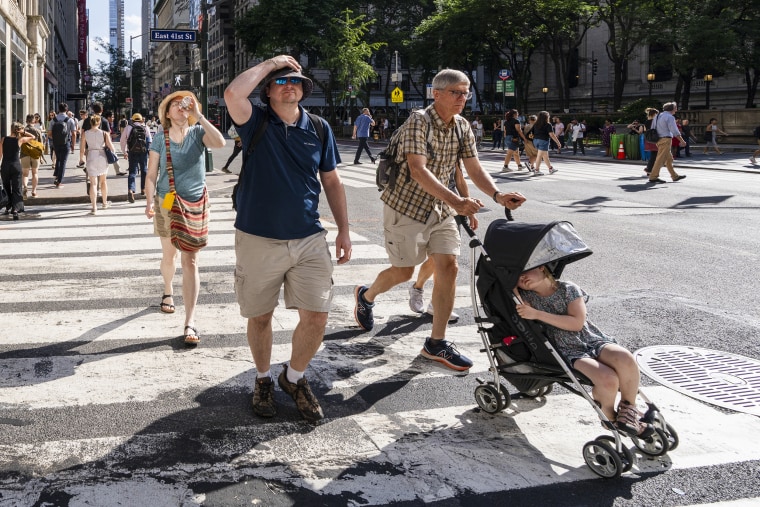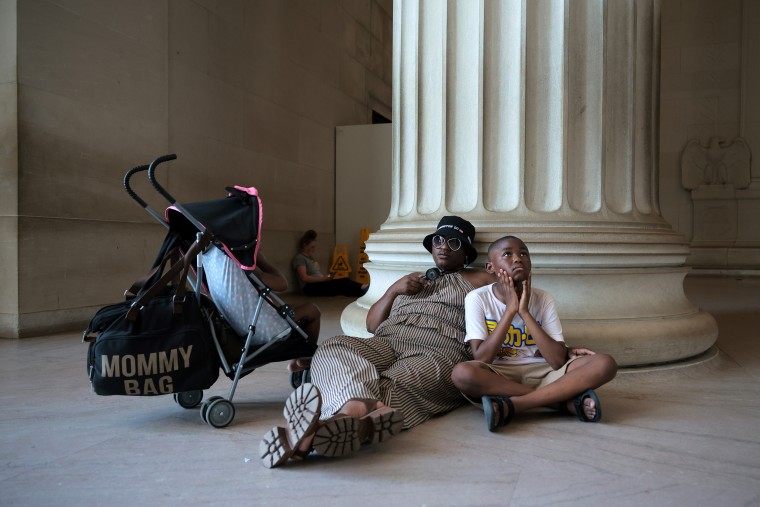Share this @internewscast.com
Approximately 150 million individuals were experiencing heat advisories and warnings by Wednesday morning. The relentless heatwave affecting the eastern half of the nation, which has already shattered numerous temperature records, appears to be persisting without any relief in sight.
The National Weather Service has described the situation as “extremely dangerous,” with the Ohio Valley expected to continue facing scorching temperatures through Friday. More daily and monthly temperature records are anticipated to fall.
Eastern heat persists
Cities including New York City, Baltimore, Philadelphia, and Boston reached 100 degrees on Tuesday, alongside various areas of Maine. Numerous heat records have been surpassed this week across the eastern United States.
Tuesday was New York’s hottest day since 2012, as voters lined up for the Democratic Primary election. Wednesday will see another day in the late 90s with overnight temperatures in the low 70s.
New York Gov. Kathy Hochul warned in a Tuesday statement that the electricity grid downstate was approaching “peak capacity” as people cranked up their air conditioners.

“It is critical to conserve electricity between now and 10:00 PM. That means setting window air conditioning units to 76 degrees and avoiding unnecessary appliance use,” she said, while adding that it was still “critical” for people to stay safe in the dangerous heat.
The Washington Monument was shut for a second consecutive day on Tuesday as both locals and tourists felt the heat, and Newark Airport reached 103 degrees, the hottest it’s been since 1966.
The heat has turned fatal, with authorities confirming that a woman in St. Ann, Missouri, died Monday of heat-related causes. Local Police Chief Aaron Jimenez said she died at home after having no water or air conditioning for at least three days.
Two 16-year-old hikers suffering from heat exhaustion had to be rescued from Gap Mountain in Jaffrey on Tuesday — one had to be carried down the mountain to a waiting ambulance, New Hampshire Fish and Game Conservation said on Facebook.
NBC Chicago reported that the heat was enough to buckle a section of road in Missouri, and three Chicago-area hospitals were struggling with their air conditioning, leading some patients to be moved.
Cumulative health risks
The NWS warned of the heatwave’s cumulative health effects and stressed the importance of drinking enough water and finding somewhere cool, especially for vulnerable groups such as the elderly and those with pre-existing health conditions.
“This is after several consecutive days of oppressive heat, which should exacerbate heat-related health impacts. This level of heat is dangerous to anyone without effective cooling and/or adequate hydration,” the service said.

“You get the combination of the extreme heat and humidity but no relief,” Jacob Asherman, a meteorologist at NOAA’s Weather Prediction Center, told The Associated Press. “It’s kind of been just everything stacked on top of itself…. It just speaks to how strong this heat wave is. This is a pretty, pretty extreme event.”
Elsewhere, scattered thunderstorms will hit the Southwest on Wednesday, with possible flash flooding in parts of New Mexico and Texas.
Cooler weather on the way
The heat should ease as the week goes on. A new cold weather front is moving through the Mid-Atlantic, bringing highs closer to 90 degrees and, for some areas, the 80s or even 70s.
“There’s even a rare backdoor cool front that will drop southward from New England to part of the mid-Atlantic region during the middle and latter part of this week,” AccuWeather Senior Meteorologist Brett Anderson said. “This can dramatically drop temperatures by 20-40 degrees in some cases, which is about as big as it gets this time of the year.”












